They Signed Up to Grow Weed. Then New York State Pushed Them Into the Black Market
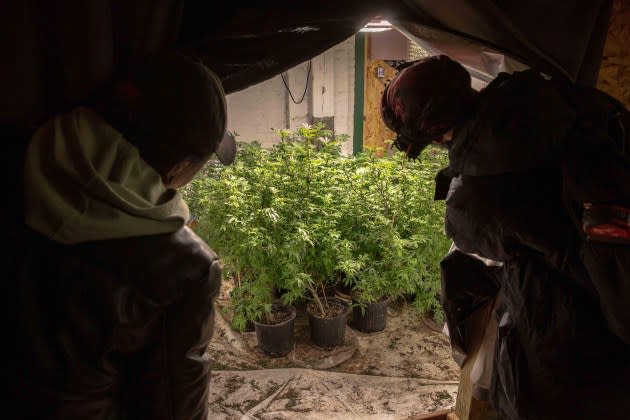
On a rainy day toward the end of September, a longtime underground marijuana grower we’ll call Shawn coasted up I-86 from the Hudson Valley to Rochester to meet with a legal farmer. The farmer hadn’t been able to sell his harvest for over a year, despite owning a fully operational and licensed farm, and he wanted to talk to Shawn about moving his product into the illicit market.
Up for grabs was the bulwark of an acre of premium outdoor grow, over a hundred pounds for sale, so long as Shawn had the money. He hoped to take the weed and move it into an intricate network of pot peddlers and dealers he had built throughout the years of the War on Drugs. It was cheaper than growing it himself.
More from Rolling Stone
The Government Set a Fire in New Mexico. It Burned 341,735 Acres
'My Generation Has Been Destroyed' - Inside the Mental Health Crisis Facing Michigan's Muslim Youth
Cannabis, illegally shipped in from other states — fueled in part by a new and booming illicit market based in unlicensed weed bodegas — had driven down profits for old-school tri-state growers. Shawn hoped the large transaction could help him recoup the recent losses.
“You can move a lot of that onto the street right now because of the price point. If someone has 50 or 100 pounds, and you have the capital to buy it, you’re going to set the price,” says Shawn. “We call it the bag. If someone comes with the money or the bag. The farmer will take the bag everyday.”
Just a few months before this, the deal would have seemed impossible: New York’s longtime underground growers, excluded from receiving the state’s first pot licenses, resented the newly licensed farmers. They had limited experience growing the plant, but were going to be the first to make a legal business off it. The relationship shifted after New York, in less than two years, fumbled its market, creating a bottleneck in the supply chain that threatened to shut down many of the first legal farms at the same time as it upended the state’s existing cannabis market.
Multiple licensed farmers confirmed to Rolling Stone they had resorted to selling pot off the books to stave off crushing debt, with legacy growers — loosely defined as growers, like Shawn, who supplied the market during prohibition — moving their legal harvests into black market supply chains.
In what legislators have deemed an “agricultural emergency,” farms are sitting on over 250,000 pounds of weed that is slowly rotting, after regulators failed to open stores on time. “We’ve been begging for support to effectively very little response,” said Senator Michelle Hinchey, Chair of the Senate Agriculture & Food Committee, at a subcommittee hearing in Albany.
Cannabis seemed like a manageable new cash crop when New York first awarded the licenses in April 2022 to small and medium sized farms as part of an agricultural revitalization program, but according to interviews with over two dozen farmers, weed has begun to steer the route of traditional farming — meaning tight bottom lines, corporate competition, and uncertain planting seasons — butting up against the purpose of handing out the licenses to struggling farms in the first place.
“I wanted to do everything by the book. I can lose everything because of this, so it’s a big fucking deal,” says one small farmer, Jan, located upstate. She had just sold five pounds of weed grown in 2022 to a dispensary on a Native American reservation. “I have to pay my taxes. I won’t be able to reapply for the official growing license if I don’t pay them. There is also my late mortgage payments. There’s no food on my table.”
The state, it seemed, knew the illegal siphoning was taking place. According to leaked audio obtained by Rolling Stone, regulators were aware of the illegal products funneling through licensed farms. “We quickly found out a lot of them are doing it,” says Damion Fagon, chief equity officer at the Office of Cannabis Management in the recording. “There was a lot of trust put in hemp farmers to not do this.”
A spokesperson for the Office of Cannabis Management told Rolling Stone “Addressing diversion of product from a licensee to an unlicensed, Illicit entity, is a very serious matter and one of OCM’s top priorities.” But according to the audio, the agency had turned a blind eye out of fear of creating chaos in an already struggling marketplace. Rolling Stone verified the authenticity of the audio.
“New York will be home to the world’s most important cannabis market, creating thousands of jobs, launching successful international brands, and investing money in communities most harmed by cannabis prohibition. However, we are still building the supply chain,” Christopher Alexander, executive director at the OCM, tells Rolling Stone. “We are committed to learning from this moment and providing stability for New York’s licensed operators.”
A last-minute reversal in regulations last year, spurred in part by the need to license more stores, opened the door for more corporate competition to enter New York’s market.
Dispensaries have opened at a faster rate so far this year, with over 50 in the past three months bringing the total to 83, though that’s still far below the 300 stores expected by this point. The question for farmers is whether they can last long enough to see the number of stores catch up with the glut of weed waiting to be sold. And for some, after two years of a supply chain snarl that knocked out entire harvests, they may never fully recover.
“There are licensed growers that I know of, and if I call them and say, ‘Hey, I need 10 pounds of whatever you have.’ I know they’re going to give that shit up in a second,” says Shawn. “I just hope that they can make enough to break even and be able to go at it once more. These farmers are using words like ‘self harm’ and ‘suicide’ when they show up to state hearings. It’s fucked up out here.”
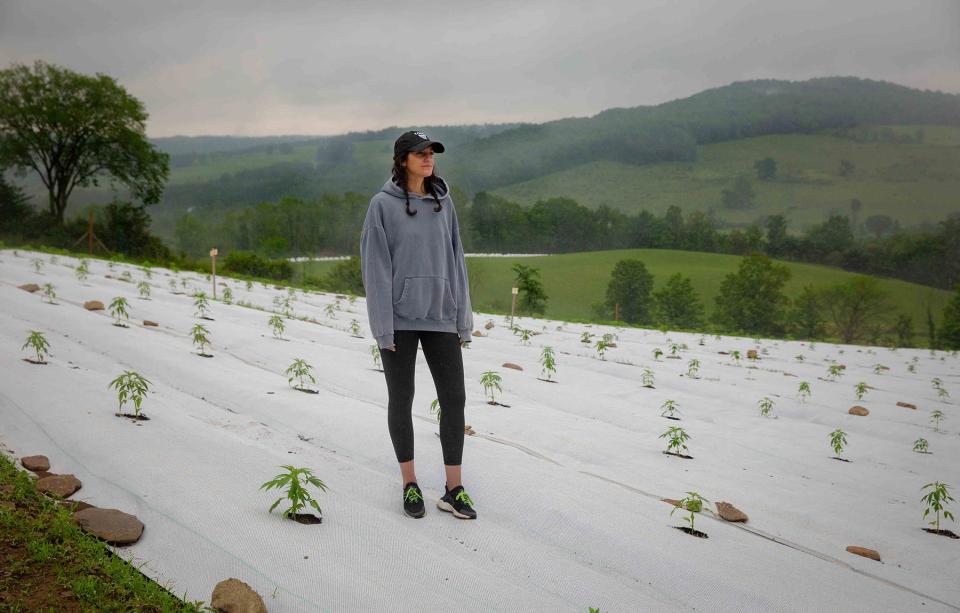
AT THE OUTSET OF New York’s recreational market — before the thousands of pounds of rotting bud, before a gnarled supply and before whole harvests were at stake — farmers were eager.
New York designed a blueprint for weed that valued social equity and small business over efficiency and quick tax dollars. Lawmakers told farmers the Empire State wanted sun-grown weed from local farms over corporate, indoor weed. Regulators even went so far as to say they would box the largest companies out of the market for three years.
“New York said we would have the market to ourselves,” says Brittany Carbone, a grower in Tioga County and the owner of a local craft cannabis company, Tonic. “We rushed into it with the promise that this is going to be worth it.”
Hopes for the agrarian focused market quickly slipped after regulators failed to open stores on time.
The state awarded the first retail licenses to people previously arrested for cannabis, an equity program meant to chip away at the lasting wrongs from the War on Drugs. Dispensary license holders were promised turnkey storefronts, eliminating the most restrictive factors to opening a store: capital and real estate. It was a monumental moment for what was once the nation’s leader in pot arrests; New York made more arrests for cannabis in 2010 than Texas. But months into the program, the state struggled to raise the money or lock down the real estate necessary to build the stores. Multiple lawsuits dogged the agency and eventually froze the licensing system all together.
By December 2023, nearly two years after the first growing licenses were awarded, only 27 licensed dispensaries dotted the state — leaving 280 licensed growers with a collective $6 billion worth of product waiting.
“What started off as a really good licensure system concept, to be able to create generational wealth through retail dispensary licenses, met governmental bureaucratic inability to get stores open,” says State Senator Jeremy Cooney, the chair of the legislature’s subcommittee on cannabis. “It created a backlog in the entire market. The farmers, they did everything they told us they would do, and then there was no place to then actually sell their goods.”
In the absence of legal dispensaries, a rampant black market flourished, with upwards of 10,000 illegal stores cropping up across New York, selling cannabis grown in other states.
“The unfortunate reality was that it was not worth it,” says Carbone. “It put people in an even worse position than they were already in. It’s getting harder and harder to sell outdoor flower that was harvested ten months ago.”
At a state board hearing in September, cultivators drove to Albany to plead with regulators. While the meeting was live-streamed, farmers made it a point to be there in person. In the packed room, standing room in the back, they described laying off workers or selling tractors and equipment to pay mortgages and back-taxes. Others said they led weekly wellness checks to make sure growers were not spiraling too far into depression or, in some rare cases, suicide.
Lined up one after the other, in front of a single microphone, the crowd cheered each speaker on. “We are going to have to get creative, the carpet has all but been rolled out for corporate interest, and the marketplace is now dangerously close to teetinger out of balance,” said one farmer, Jeff Jones, his hands bandaged from work in the field.
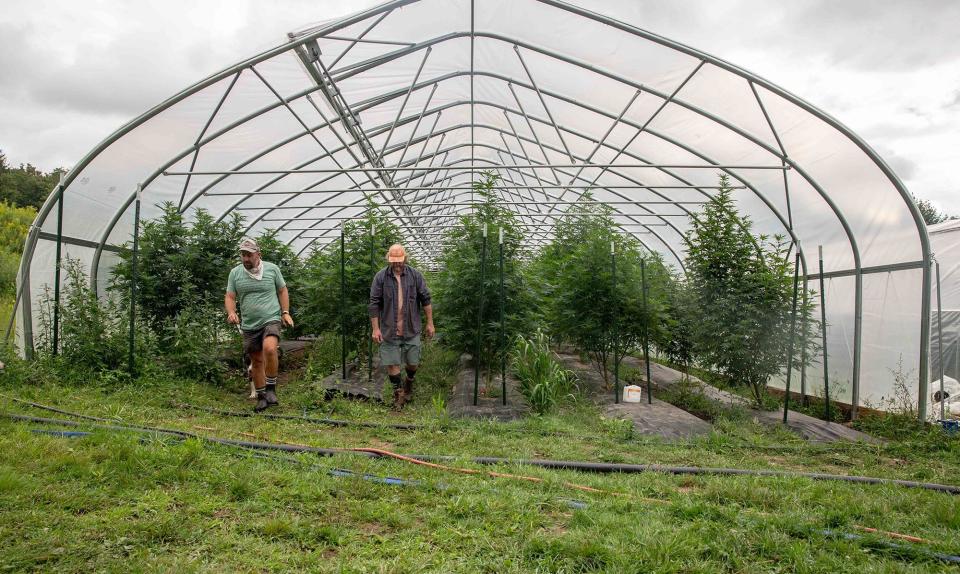
Standing before the seven member Cannabis Control Board, hoops and hollers, tears punctuated the meeting. They ultimately fell on deaf ears.
Officials successfully passed regulations at the hearing that would allow large weed conglomerates into New York’s market ahead of their scheduled time. The original three-year embargo on the corporations was supposed to help farmers stock cash and expand their infrastructure in order to stay competitive.
According to several sources, including former employees at the OCM, Albany insiders, and attorneys representing weed corporations involved in litigation with the state, officials backed out of their three-year promise to farmers after a coalition of corporations successfully filed a lawsuit against the state and unleashed a PR blitz, including full page ads in the New York Post and Daily News. “The governor didn’t like the lawsuits,” said one source, not authorized to give their name. Governor Kathy Hochul declined to comment.
The Office of Cannabis Management maintains the reverse in policy was intentional, in order to open more stores and alleviate much needed shelf space.
IN 2019, DEMOCRATIC SENATOR CHUCK Schumer walked onto a farm outside Buffalo, up a long gravel driveway, shaded under 30-foot oak trees. He stopped in front of a 100-year-old Victorian Farmhouse — a gem leftover from an era of upstate farming and industrial production. Standing next to the cream colored home with maroon inlay and white lattice trim, Schumer held a press briefing about the need to regulate the CBD market appropriately.
Hemp — a cousin of cannabis that doesn’t contain THC, the chemical that causes psychoactive effects — had been recently legalized nationally in the Farm Act of 2018, and prices were crashing.
Only a few months later, the owners of the farmhouse, Gina and Terry Miller, could no longer afford to put seeds in the ground. The couple had suffered too many losses planting hemp, losses that cut into their nest egg. “It was a photo opportunity for him but it was definitely a photo opportunity for us. But there was just no money in hemp,” says Gina.
When the new THC licenses were announced — awarded to farms that had previously enrolled in the state’s hemp program as a way to help them recover losses — the Millers hoped growing THC-rich cannabis could help them bounce back. They invested $50,000 in 2022 to get their crop in the ground, but were unable to find a store able to carry their product. “Cannabis is a crapshoot, it’s like Vegas,” says Gina.
With little retail options across the state, the Millers couldn’t afford to grow again. Currently, they are sitting on a quarter-million dollars worth of THC oil, even as their license is set to expire.
“We thought it might help offset rising taxes because social security isn’t going to keep up with costs of living and we wanted to stay here,” says Gina, standing next to an empty one-acre plot where her cannabis had grown. One-off weed plants scatter the field. The value of her THC oil had dropped almost in half since it was extracted. “It was like a win-win. We knew we would have to invest some money, but we felt we would see it on the back end. That’s not how it happened.”
Gina and Terry say that while Buffalo had only one licensed dispensary operating over the summer, illegal weed bodegas had cropped up around the city selling product at a steep markdown — much of it imported from illegal grows run by foreign crime syndicates in Oklahoma, according to the Oklahoma Bureau of Narcotics.
“The governor promised 20 stores by the end of 2022 and 20 every month after, people made plans after the government said such. They ramped up their efforts, they robbed Peter to pay Paul,” says Joe Rossi, Cannabis Practice Group Leader at Park Strategies, a consulting firm. “By the end of 2023 there were only 30 stores, not 260. That math fucked them completely.”
WHILE REGULATORS AWARDED the first cannabis licenses to small farms, skipping over legacy growers who took offense, legislators created a separate “mentorship program”, to bring black-market growers into the legal fold. The course was novel as it created a pathway to licensure for the underground and untaxed, for the creators of the industry, to have a shot in its future.
The classes paired legacy growers up with a mentor: a licensed farmer who could give them advice around staying within the lines of legality.
At the first of 10 online sessions last January, hardened growers went off in the course’s chat box. Images of frosty trichomes and top shelf buds populated the screen. Damian Fagon, the Chief Equity Officer at OCM, laughed, the mood was ebullient. “Photos of some really great weed were shared,” he said smiling. “Class is in session.”
Questions ensued, “When do we get a license?” “Don’t miss this opportunity to voice your opinions, the onus is on us to step up.”
Ultimately, growers left the course wary: many were pleased as the course added bonus points to any legal application in the future. Others were concerned about the viability of the market after watching how their mentors, the licensed farmers, had fared. The looming corporate entrance stoked fear.
Inadvertently, the state placed two groups, distressed farmers and legacy growers, in the same room, while both of them were caving under financial pressure.
Usually at odds with one another, licensed farmers began reaching out to legacy growers they met through the course to help them navigate the ins and outs of growing high quality THC. New York’s old-school growers, on the other hand, silently found places for the struggling farmers’ products, moving them into networks of neighborhood weed dealers and illegal dispensaries.
“We were all failing together at the time,” says Shawn who met the licensed farmer he planned to buy from through the course. “It opened up some possibilities.”
“What do you do when you can’t pay your bills? It’s not something you want to do, but for a lot of people it’s selling now or losing your farm,” says another struggling farmer, granted anonymity to protect his license. “It’s not a matter of wanting to make money, it’s a matter of needing to make money.”
According to the Legacy Growers Association, an advocacy group for New York’s long standing pot planters, “there was a divide between the small farmers and legacy” but after the harsh first year and with steep competition coming into the market, many found it was simply easier to work together.
“We kind of saw each other as enemies. But after the Office of Cannabis Management fucked the small farmers over, we’re like, ‘oh, you know, we’re all the little people,’” says Joshua Waterman, head of the LGA. “At this point, it’s us versus the big corporations that are coming in.”
Waterman remembers his great grandfather selling their family dairy farm as turning a profit became difficult in the face of big agriculture. He says that by allowing cannabis corporations into the market early, regulators lost the trust of many hardened legacy growers who operated on mutual trust and handshakes.
“I’m from upstate, a lot of these people that I know, we’ve seen agriculture get destroyed,” says Waterman. “For small-time people, or a small community like the legacy community in cannabis, corporations just completely destroy every moral and everything that we’ve ever had.”
Shawn applied for a license, but was not accepted in the initial round. With weed prices plummeting in the black market, his family’s future may depend on securing one. Waterman was awarded a legal license in February.
“Whaddup grow fam,” said Waterman via instagram live in February, announcing his license to some 5,000 fellow growers and followers around the state. “We weren’t supposed to be here, but here we are.”
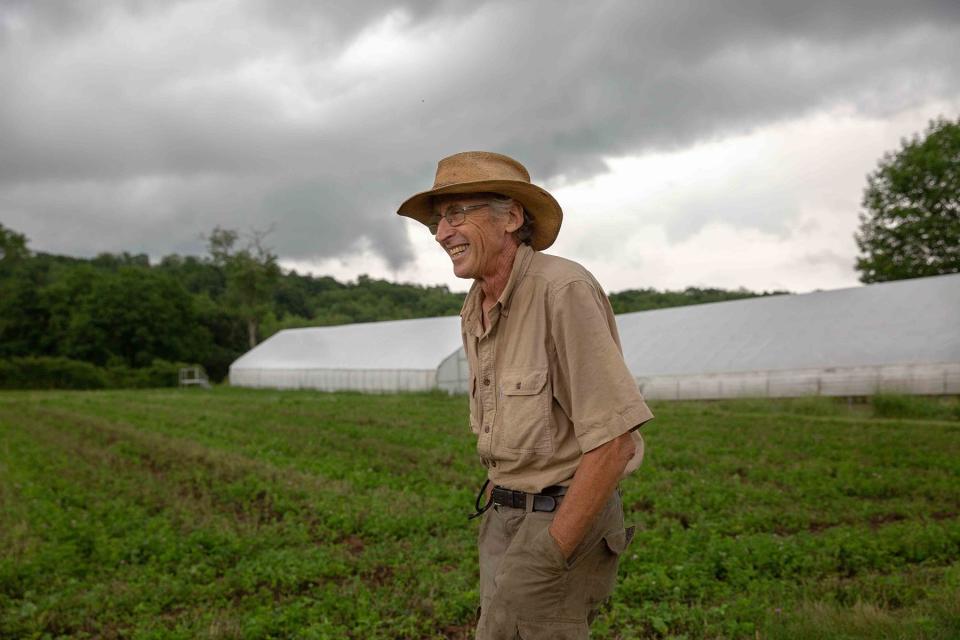
PERCHED ATOP A ROLLING HILL outside of Argyle, New York, a sleepy town of about 3,500 people, Seth Jacobs stands sweating on top of a refrigerated shipping container. He tied shade covers over the canister, hoping to keep the July summer sun at bay. Inside, 700 pounds of weed grown the previous year was at risk of going bad.
“It’s just coming out of our savings at this point, me and my wife’s retirement,” says Jacobs, an organic vegetable farmer of 30 years. “We’re in crisis mode on all these farms. It’s pretty severe what’s going on down here. The calls we’re making about what to do. What bills to stop paying and what expenses we can afford.”
Jacobs made a solid middle class living through organic farming, but in recent years, he says, turning a profit had become more laborious. Vegetable harvests were hard and time consuming and his kids were cautious of maintaining the workload after the farm was in their hands. Cannabis seemed like a manageable new cash crop.
Now, Jacobs is wary that he’s handing off the farm to his two sons while corporations threaten to undercut and out-produce him. Rudimentary business tasks, like finding a bank or insurance provider, became more difficult, as federal narcotic laws prevent basic financial institutions from servicing marijuana companies.
“I’m not willing to partner. I don’t have a lot of capital, but I’ve been an independent party my whole life. So the question is, is there room for people like Seth in this business?” says Jacobs, sitting with his legs crossed under an electric-powered shed he installed under an Obama-era grant. “But this sounds to me an awful lot like farming, well, since time immemorial.”
Fifty miles away from Jacobs, nestled in hills outside Albany, Kate Miller tended her rows of cannabis. It bothered her that some of the first licensed farmers were double dipping in both the legal and gray markets.
“I’m following all of the rules. I’m doing everything you told me I was supposed to do. I am selling at either a loss or breakeven point just to continue keeping going,” says Miller. “And there’s a guy who has a license and he’s growing and selling directly out of his place and the OCM knows about him and has done nothing.”
A farmer of 13 years, Miller specializes in certified organic fruits and vegetables, often infusing them into beverages she sells to higher-income clientele that frequent the nearby Saratoga Springs’ horse track. Some years she did well, others were a challenge. Cannabis seemed like it could solidify her homestead into a farm with staying power.
Instead, Miller has for the most part begun selling her cannabis at a loss to any of the few dozen dispensaries that will take it.
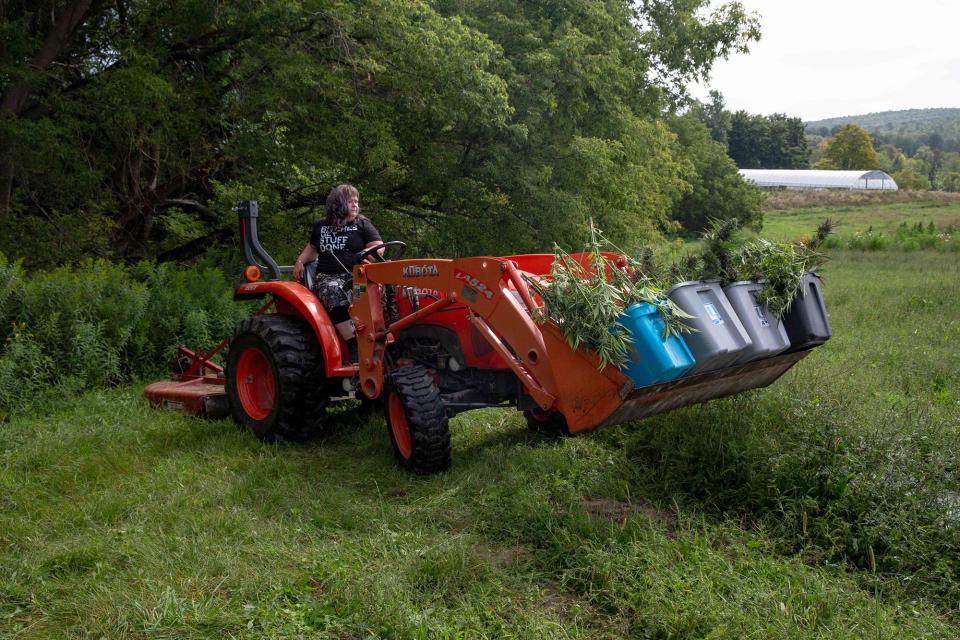
“Someone called me the cheapest girl at the dance,” says Miller, who heavily discounted her products to raise funds for this year’s harvest. “But it’s more like the Wall Street trading floor during the great depression. You sell, sell, sell, because we don’t know where it’s going from here. How low it can go.”
Farmers hoping to attract investors are struggling even though just a year prior, they were in-demand, according to the Cannabis Farmers Alliance, a trade association for small pot planters. The combination of debt-ridden balance sheets and few stores in which to sell the new harvest frightened investors who wanted to see which brands could survive the tumultuous first years.
According to Miller, last year’s harvest will likely decide whether or not she will be able to stay in the market: a three month runway. She hoped to build a greenhouse and a curing room on her farm this year to stay competitive with the corporations entering the market, but sitting over at her table the day after Christmas, elbow deep in paperwork, she was running over payroll, trying to find the funds to pay her workers, any necessary infrastructure a second thought.
What got her into agriculture to begin with was the belief that a farm could exist without having to scale to corporate levels, whether that be a vegetable farm or a pot farm, she says.
“From a financial standpoint, it’s just fear. Like is everything going to go away?” says Miller, who sunk over $300,000 in her cannabis operation. “But I’ve also always been that person that resisted the idea in farming that the only way to make money is to get big. I don’t think that’s necessarily true. You can do well by being small if you create a good quality product that people want to have.”
She paused, sitting on top of an orange tractor, her eyes scanned the three farm hands in her field. This time last year there were 12 workers. She wasn’t able to afford them this season.
“But when there are no stores, how are the consumers going to know that you have a product worth investing in? That you are a brand that’s worth sticking around?” she says, before lifting her chin, and setting her eyes. “But we can’t think that way. It takes me nowhere. We keep at it, one step at a time, and wait to see what happens.”
Best of Rolling Stone

